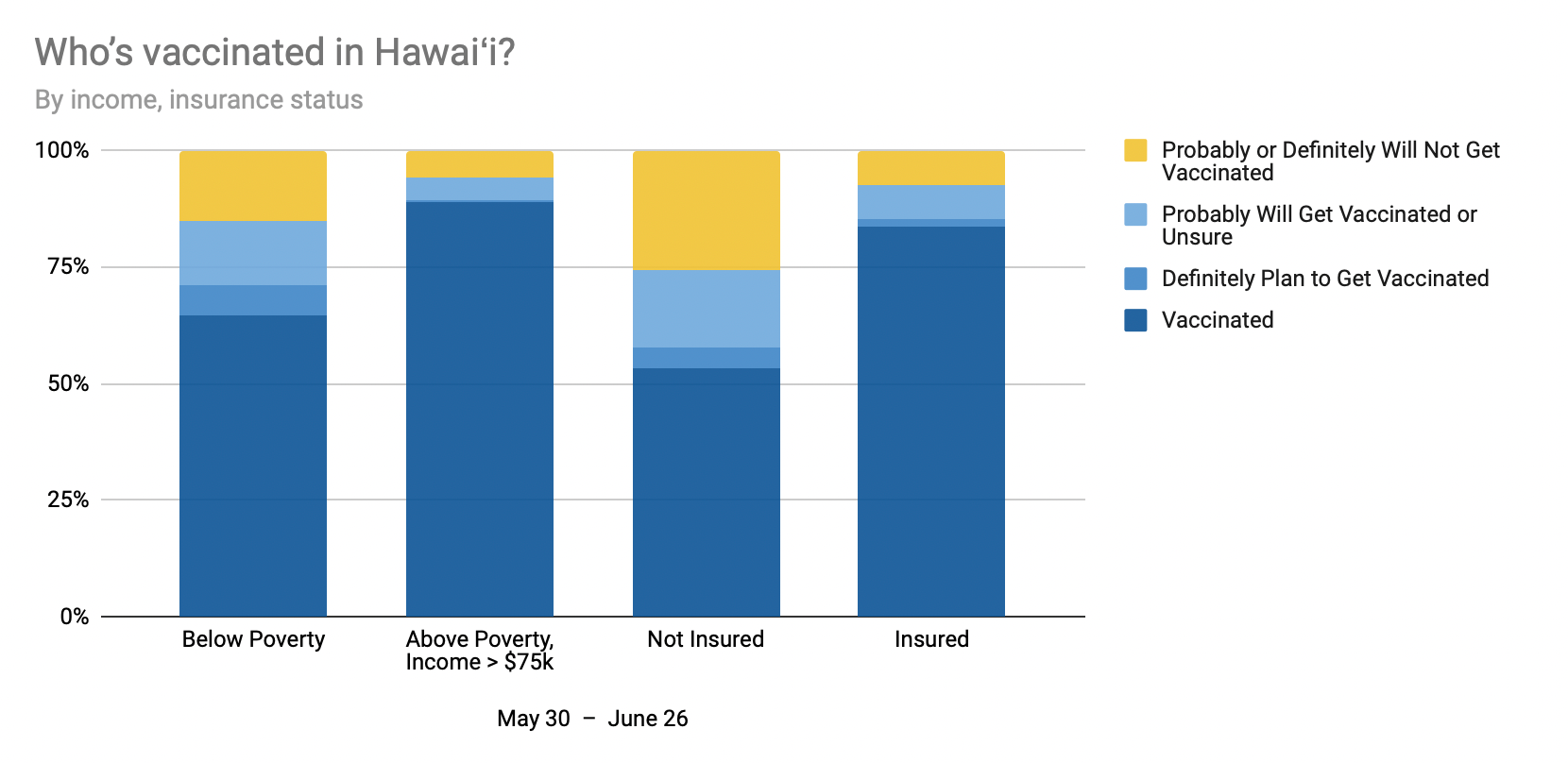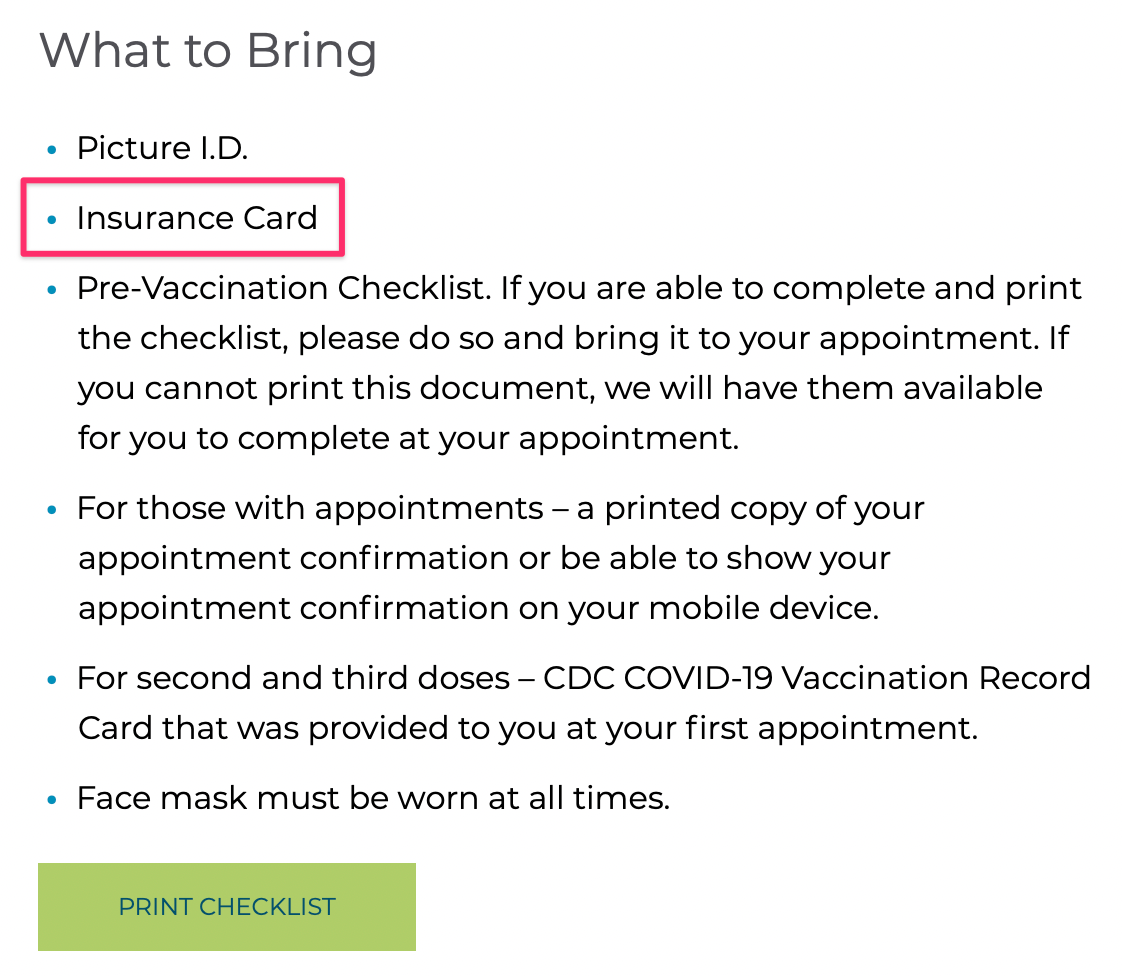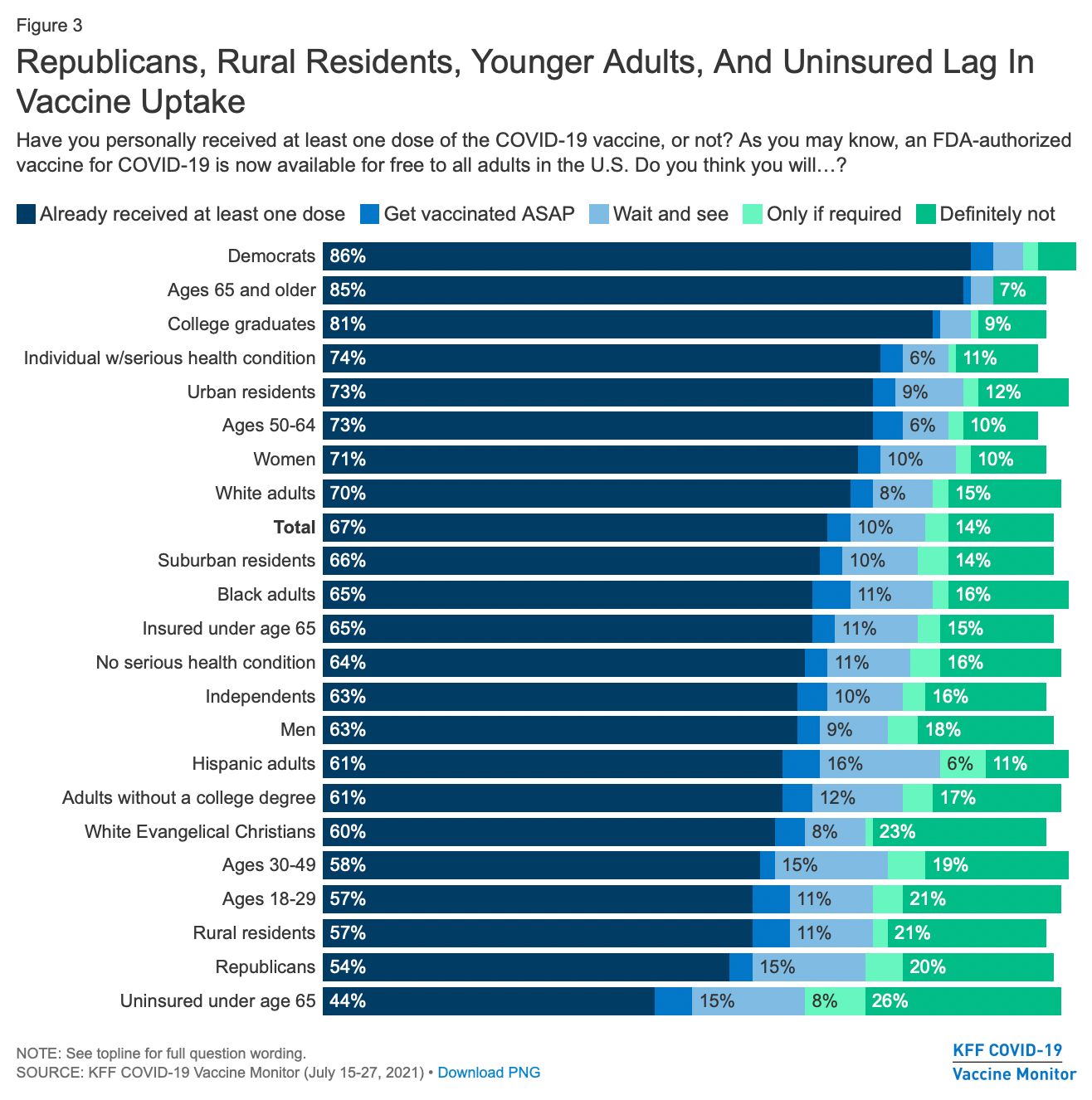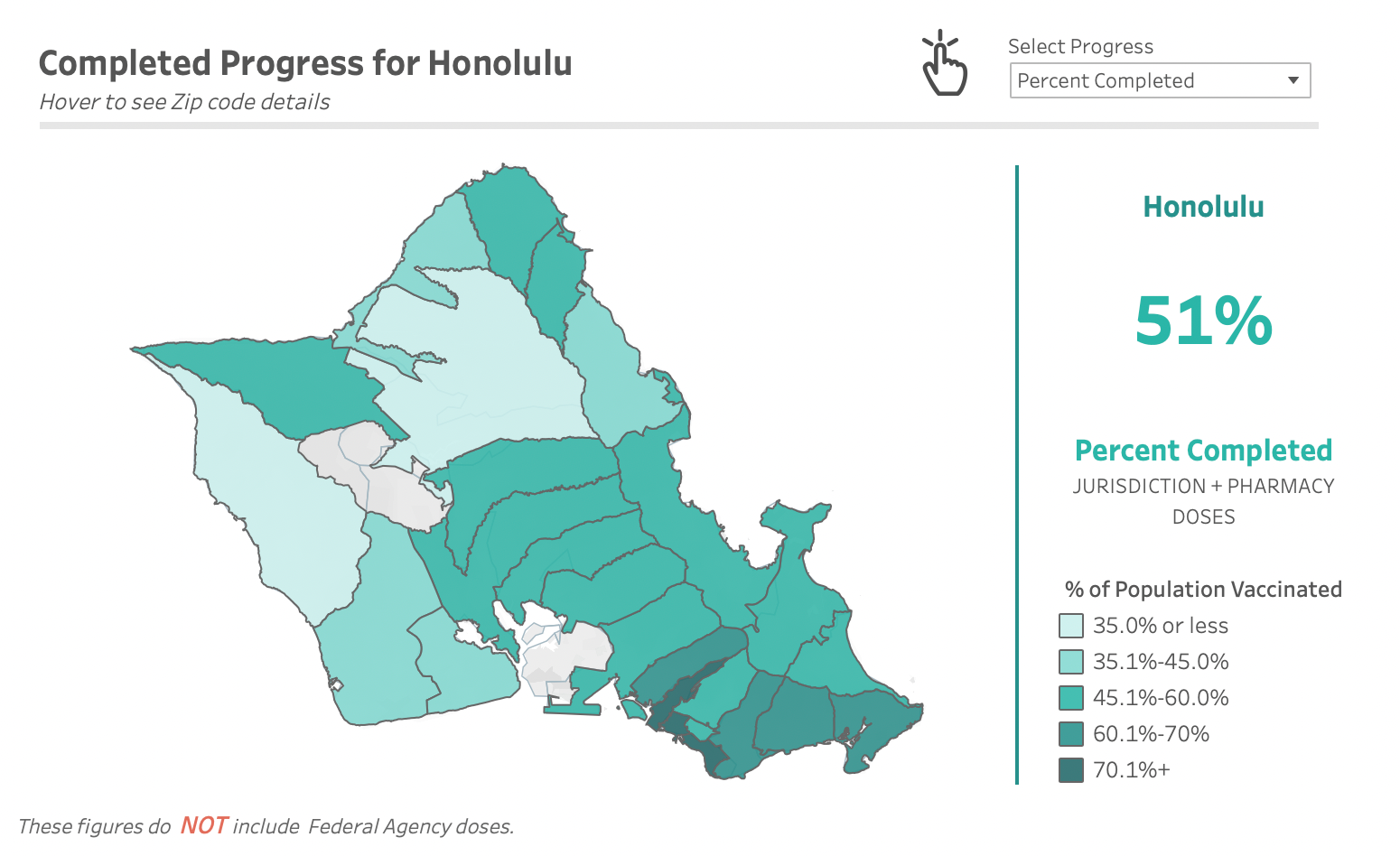
Why has Hawaiʻi’s vaccination rate remained sluggish since early July? We know it’s not just antipathy to the vaccines. National experts have emphasized that unvaccinated people are not a monolith — that there are multiple, complex reasons for not yet getting the shot — and Governor Ige acknowledged yesterday that outreach to Native Hawaiian communities is falling short.
Additional Hawaiʻi-specific data suggests there are other barriers to vaccine access:
- Like the US at large, uninsured and low-income people in Hawaiʻi have much lower vaccination rates, according to the CDC.
- Areas with lower vaccination rates have fewer vaccine sites per capita than areas with higher vaccination rates on Oʻahu.

This raises the question: Are state leaders doing everything they can to make vaccination as easy and convenient as possible?
Hawaiʻi’s daily vaccination rate peaked in early April, then again in mid-May — around when the Pfizer vaccine was approved for children ages 12-15 — and it hasn’t picked up since then, according to the CDC. It would benefit all of us for the state to reduce any remaining barriers to getting vaccinated.
Economic barriers
In an article last week, The Washington Post spoke with a worker in Denver who said “he has been working 60-plus-hour weeks for months … He’d like to get vaccinated, and believes everyone should get the jab, but said he hasn’t had the time or mental space to do it.”
The Post identified one systemic culprit: “a lack of paid sick leave,” which is “playing a role in deterring low-wage workers from taking time off to get vaccinated. … Workers who do not get paid time off to get the shot or deal with potential side effects are less likely to get the vaccine, research by a Kaiser Family Foundation study shows.” (Concerns about side effects are the leading national cause for vaccine hesitancy, according to a Census Bureau tracking poll.)
Hawaiʻi has a high share of economically precarious workers. Three in five Hawaiʻi households are struggling to make ends meet, according to Aloha United Way, and almost a quarter of Hawaiʻi workers had multiple jobs, according to a 2019 survey.
This aligns with research from May, which found that about one in six vaccine-hesitant people in Hawaiʻi were “cost-anxious”: “People for whom time and financial cost are the primary barriers. Every member of this group has delayed seeing care for their health in the past due to cost regardless of insurance status.” Overall, the top barrier that residents experienced was “difficulty traveling to a vaccination site.”
(The largest share — nearly half — of vaccine-hesitant residents were characterized as “watchful,” meaning “people who primarily need to see friends and peers having safe, positive vaccination experiences before they will commit.”)
The Post quoted one vaccine clinic manager who summed up the dilemma faced by workers without paid sick leave: “It’s a big deal — it’s either miss work and get the vaccine, or continue to go to work to keep up with your paycheck.” If there’s no vaccine clinic nearby, it’s going to be an even harder sell.
Unvaccinated people may also have questions about cost. The vaccine is free, whether or not you have insurance, but this message is often muddled. A technical term like “no out-of-pocket cost” doesn’t really sound equivalent to “free,” and pre-vaccination checklists often instruct people to bring an insurance card. Deciphering these terms and requirements is unfortunately another burden.


Given the inconsistent messaging, it’s logical that “some unvaccinated adults cite concerns about a surprise bill,” according to the New York Times. Many people with concerns are “accustomed to a health system in which the bills are frequent, large and often unexpected.” Nationally, uninsured people under age 65 have the lowest vaccination rates, according to the Kaiser Family Foundation.

Barriers to access
There’s no single government source with a truly comprehensive list of vaccination sites in Hawaiʻi. Vaccines.gov, the federal government’s website, lists many of the major pharmacy locations, but doesn’t include many of the local pop-up clinics. The state’s portal, HawaiiCOVID19.com, only links to the individual county websites. Each county maintains its own listings on its own website, and those county websites don’t include the federal data. Moreover, some temporary clinics can really only be found on social media—basically by word of mouth.
At my organization, Hawaiʻi Children’s Action Network, we’ve been compiling vaccine locations from each of those sources into one comprehensive directory. As far as I can tell, this provides the most inclusive, statewide view on vaccination availability.
The hodgepodge of data is one issue. But by analyzing the data compiled by HCAN, along the DOH’s public vaccination tracking data, I was able to see an even bigger issue: Areas on Oʻahu with higher vaccination rates have more vaccine sites per capita than areas with lower vaccination rates.
It seems like ideally, this should be reversed — that vaccination sites should be concentrated in areas with lower vaccination rates. Like last year’s “surge testing,” can we also surge vaccine sites in the areas that need it most?

ZIP codes with 35% or less of their residents fully vaccinated have a total population of about 93,500. Those ZIP codes have just 16 publicly listed vaccination clinics (including those listed on Vaccines.gov, OneOahu.org, and more), meaning there’s one vaccine clinic for every 5,800 residents.
On the other extreme, ZIP codes with 70.1% or more of their residents fully vaccinated have a total population of 70,700, and 48 vaccine clinics. This is a ratio of about one clinic for every 1,500 residents.
The trend continues even after broadening the categories. ZIP codes with less than 45% of their residents vaccinated, and those with 60.1% or more of their residents vaccinated, each have about 225,000 total residents. But the areas with 45% or less vaccinated have only 45 vaccine sites, a ratio of one clinic for every 5,000 residents. The areas with 60.1% or more vaccinated have 86 vaccine sites — or one clinic for every 2,600 residents.
This disparity is even suggested by a quick visual comparison between vaccine sites (as mapped on HCAN’s directory) and the DOH’s map of vaccination rates.


For this analysis, I looked only at Oʻahu vaccination sites, which are the most up-to-date in our directory. (Oʻahu sites were last updated on August 23, 2021.) From there, I calculated the number of vaccination sites in each ZIP Code Tabulation Area (ZCTA), then compared those to the vaccination rates per ZCTA, using the Department of Health data. To get the resident population of each ZCTA, I used data from the Department of Business, Economic Development & Tourism’s 2020 Data Book. Click here to see the full data.
For weeks, state leaders have been pleading with Hawaiʻi’s unvaccinated residents to get vaccinated. But with our state’s daily vaccination rates virtually unchanged since early July, it’s time to think about the bigger structural barriers preventing people from getting vaccinated — and work to eliminate them.
